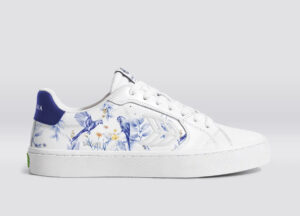Art has always been about innovation—pushing boundaries, reinterpreting the familiar, and using unconventional materials to create something thought-provoking. One artist who has mastered this approach is Adam Hillman, a conceptual artist known for his meticulous arrangements of everyday objects. His works transform mundane materials—candies, pushpins, utensils, and, in this case, paper clips—into stunning, intricate compositions.
One of Hillman’s most remarkable pieces is his recreation of Edvard Munch’s The Scream, but with a twist: instead of paint, he used carefully arranged colored paper clips. This piece is more than just a clever homage to the famous painting; it’s a testament to the intersection of art, design, and modern creativity.
But why The Scream? And why paper clips? Let’s explore the significance of Munch’s masterpiece, Hillman’s artistic approach, and the broader implications of reimagining classic art through unexpected materials.
The Original The Scream: A Masterpiece of Emotion
Before diving into Hillman’s version, it’s crucial to understand the historical and emotional weight of Edvard Munch’s The Scream. Created in 1893, the painting is one of the most recognizable artworks in history, embodying existential angst, modern anxiety, and emotional turmoil.
A Glimpse into Munch’s Inspiration
Munch himself described the inspiration behind The Scream in his personal diary:
“I was walking along the road with two friends. The sun was setting. Suddenly, the sky turned blood red. I paused, feeling exhausted, and leaned on the fence. There was blood and tongues of fire above the blue-black fjord and the city. My friends walked on, and I stood there trembling with anxiety—and I sensed an infinite scream passing through nature.”
This psychological distress, this overwhelming feeling of dread, is what makes The Scream so timeless. It resonates across cultures and eras, symbolizing human vulnerability in the face of an unpredictable world.
The Scream’s Enduring Legacy
Over the decades, The Scream has inspired countless reinterpretations, from parodies and pop culture references to serious artistic studies. The image itself has been printed on t-shirts, coffee mugs, and even transformed into a meme, making it one of the most culturally pervasive artworks in existence.
Hillman’s paper clip version is another brilliant reimagination—one that not only pays homage to the original but also brings a fresh perspective to how art can be reconstructed using contemporary materials.
Adam Hillman: The Artist Who Organizes Chaos
Adam Hillman is a visual artist and conceptual thinker known for arranging everyday objects into mesmerizing patterns and compositions. His works are often described as “object art” or “meticulous arrangement art,” blending elements of photography, design, and sculpture.
Unlike traditional painters or sculptors, Hillman’s medium is the mundane objects we overlook—paper clips, colored pencils, rubber bands, cereal pieces, and candy. His talent lies in the ability to meticulously organize these items into stunning, aesthetically pleasing, and often thought-provoking patterns.
Hillman’s creative process is intensely detail-oriented. Each piece requires:
Careful color selection – ensuring contrast, shading, and depth.
Intricate arrangement – precisely aligning objects to create a sense of movement or dimension.
A deep understanding of visual composition – balancing elements so that they mimic classical artworks or form abstract designs.
His work is not digital manipulation; everything is physically arranged and photographed. The precision involved in positioning hundreds of tiny paper clips to form The Scream is a testament to his patience and skill.
Recreating The Scream with Paper Clips
Why Paper Clips?
Hillman’s choice to use paper clips is fascinating because it transforms a simple, functional office item into an expressive medium. But beyond the novelty of using such materials, there’s deeper meaning:
•Paper clips symbolize order and structure, yet Hillman bends them to depict chaos and anxiety—mirroring the existential tension in The Scream.
•They are everyday objects, making the artwork feel accessible and relatable.
•Their interlocking nature mimics the flowing, wavy lines of Munch’s original composition, preserving the painting’s surreal movement.
Deconstructing the Paper Clip Scream
Hillman’s rendition captures every key element of Munch’s painting:
The Iconic Face:
•The central figure’s terrified, ghostly expression is recreated through precisely placed loops and curves of paper clips.
•The open-mouthed scream is highlighted with a contrast of color, ensuring it stands out from the background.
The Swirling Sky:
•One of the most mesmerizing aspects of The Scream is its dynamic sky, with fiery reds, oranges, and blues swirling together.
•Hillman achieves this effect by layering paper clips in gradient-like arrangements, mimicking the brushstrokes of Munch’s painting.
The Distorted Landscape:
•The bridge’s dark diagonal lines remain prominent, creating depth and perspective.
•The background figures—Munch’s two friends who walked ahead—are subtly suggested through strategically placed shapes.
The final effect is both familiar and novel—we instantly recognize The Scream, yet we also appreciate the ingenuity of using paper clips to reconstruct something so deeply emotive.
Blurring the Line Between Fine Art and Everyday Life
By recreating a legendary artwork using a humble office supply, Hillman challenges the notion that art is reserved for canvas, museums, and expensive galleries. Instead, he demonstrates that:
•Art is everywhere, even in the mundane.
•Everyday objects can be transformed into powerful storytelling tools.
•Creativity is not limited by traditional materials—it thrives in innovation.
The Digital Age and the Reinvention of Classics
Hillman’s work is also part of a larger trend of remix culture, where artists reimagine historical pieces through new mediums. Just as Munch’s The Scream has been meme-ified, turned into pop art, and repainted a thousand different ways, Hillman’s version reflects how modern artists reinterpret classical themes for the digital generation.
His work thrives in the age of social media, where visual content is king. Unlike traditional paintings that must be seen in museums, Hillman’s artwork spreads quickly through Instagram, Pinterest, and art blogs, making fine art more accessible to a global audience.
A New Way to See The Scream
Adam Hillman’s paper clip reinterpretation of The Scream is more than just a clever art project. It’s a meditation on creativity, accessibility, and the power of everyday materials to convey deep emotion.
By meticulously arranging paper clips to recreate one of the most iconic images in art history, Hillman proves that:
•Art is not just about what we use, but how we use it.
•Classic works can take on new life through modern materials.
•Innovation in art lies in reimagining the familiar.
Munch’s original The Scream captured the anxieties of the 19th century. Hillman’s version, using something as ordinary as paper clips, reflects the creative spirit of the 21st century—a world where even the simplest objects can be transformed into something profound.
No comments yet.








